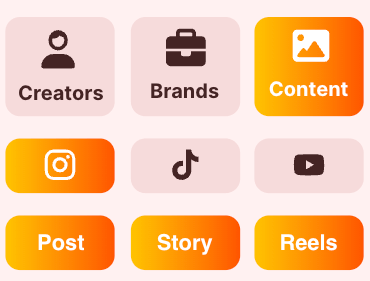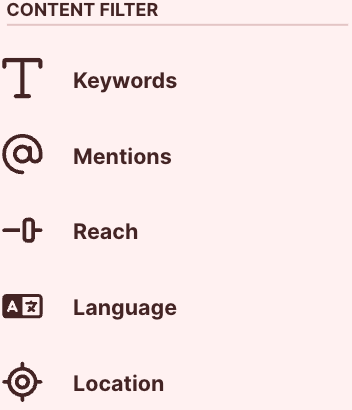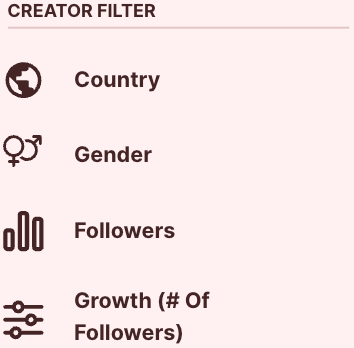
Reading time: 7 minutes
Chapter 6: Introduction to influData’s Content Search
The Essentials at a Glance
With the Content Search feature in influData, you can find social media content that fits your brand visually, thematically, and strategically – including matching creators. You can use prompts or apply filters to discover relevant posts, reels, or videos on Instagram, TikTok, and YouTube. The influencer marketing content search in influData offers the following advantages:
- The AI-powered content search detects posts automatically based on visual style and topic
- Each result includes direct links to creator profiles and performance metrics like EMV and engagement
- The Similar Image Search allows you to identify visually similar posts
- Filters help narrow results by content language, location, format, reach, and follower count
influeData’s Content Search allows you to find relevant content and suitable influencers on platforms like Instagram, TikTok, and YouTube without having to scroll through individual creator profiles. The Influencer Content Search is primarily designed to help you find content that is most suited to your brand. Additionally, it enables you to identify creators who share a similar visual language or post content that aligns with your brand’s identity and campaign goals.
Table of Contents:
- How does the Content Search work in influData?
- Using Prompt Search
- Using Filter Search
- Reviewing and refining search results
- Similar Image Search for more precise results
- Conclusion
1. How does the Content Search work in influData?
Similar to the Creator Search, you can use either our AI-powered Prompt Search or the specific Filter Search – or ideally, a combination of both methods. Combining the two offers an advantage: you start with a broad prompt to generate a diverse selection of relevant content, then refine these results with filters. For instance, you could begin with a prompt like “Fitness content from Germany” and then narrow it down using filters for specific platforms, minimum follower count, engagement level, or other relevant criteria. This combination yields particularly precise results, customized to your brand and campaign objectives.
influeData’s Content Search analyzes the visible elements in images and videos, linking them to your prompts or keywords, so you can easily and quickly discover the most suitable content.
To initiate a Content Search, click the “Content” button in the top-left menu, choose the platform you wish to search on, and select the content formats you want to explore. Different formats across platforms have unique visual appearances – for example, an Instagram Story often looks different from an Instagram Post. Avoid basing your judgment solely on the appearance or thumbnail. Stories, in particular, may appear slightly lower in quality as they are designed to be authentic and spontaneous – something that should be seen as a positive. In fact, Stories have numerous advantages, including higher visibility (as they don’t get buried in the feed) and strong engagement rates. Therefore, they should ideally be compared only with other Stories rather than other content formats.

2. How do you use prompts for the Content Search?
With the Prompt Search, you can enter a description or keyword – just like with ChatGPT – into the search bar, e.g., “Fitness Content from Germany”. The AI then analyzes the visible content in the images and videos of social media posts and shows you the most relevant results, including information about the creator and the key KPIs of the content piece, such as the number of comments, likes, reach, and EMV.
Tip for optimal results: Start with a simple prompt and gradually refine your input. Begin with a general keyword and then add more details step-by-step to narrow down the results. This approach will yield a focused selection precisely tailored to your needs.

3. How do you use the Filter Search effectively?
The Filter Search allows you to narrow down your results based on specific criteria or to supplement the Prompt Search. Here are the available filter options:
a. Content Filters:
- Keywords: Search for specific terms within the content. You can add multiple keywords. Using multiple keywords makes the search more precise as it operates on an AND basis (switching to an OR search if one keyword yields no results). To exclude certain keywords, simply place a minus sign in front. For instance, if you’re looking for fitness content but want to exclude yoga content, enter “Fitness” and “-Yoga” in the keywords.
- Mentions: Find content that mentions a specific brand or user. You can add multiple mentions, with or without the “@” symbol. Using multiple mentions also operates on an AND basis (switching to OR if one mention yields no results). To exclude mentions, add a minus sign. For example, if you’re searching for fitness influencers but want to exclude those who have collaborated with Adidas, enter “-adidas” or “-@adidas” in the mentions.
- Reach: Filter based on the estimated reach of the content.
- Language: Filter by the language the content creators generally use in their posts.
- Location: Filter based on the location tagged in the content. This can be a country, city, region, or even a landmark like the Eiffel Tower.

b. Creator filters:
These are particularly useful if you want to find creators for your brand using the Influencer Content Search.
- Country: Filter by the country of origin of the creator who posted the content.
- Gender: Choose the gender of the creator.
- Followers: Set a minimum follower count to view content only from influencers with your desired reach.
- Growth Rate: Limit the content search to creators with a certain growth rate, helping you assess the potential for collaboration.

4. How do you evaluate the Content Search results?
Once you’ve set your search criteria, influData displays the most relevant content pieces that match your inputs. You can sort these by:
- Reach
- Viral Content
- Newest Posts

For each content piece, you’ll find a range of information and interactive options:
- Go to Post: Click to view the content directly on the platform (Instagram, TikTok, etc.), with the exception of Instagram Stories, to check details like captions and comments.
- influData Profile: Navigate directly to the creator’s influData profile for further research.
- Collections and Favorites (the plus or heart icon): Add the content piece to your favorites or a specific collection for easy access later.
- Content Piece Data:
- Upload date
- Creator’s name
- Number of likes
- Number of comments
- Estimated reach
- Earned Media Value (EMV) or Paid Media Value (PMV)
- Caption for a quick content overview

5. How does the Similar Image Search work?
If you’ve found a content piece that fits your desired style or theme and want to discover similar pieces from other creators, the Similar Image Search allows you to dig deeper.
How it works: Select the content piece and click the wand icon in the top left corner. Our AI then shows you similar content that matches your selected piece visually and thematically.
Pro Tip: When using Similar Image Search, narrow down the country to your target area and sort results by “Most recent” to get the best and most relevant content for your campaign.

6. Conclusion
influeData’s Content Search enables you to find and analyze content quickly and effectively, saving you time and ensuring you always have the right content for your marketing strategy. Additionally, the Influencer Content Search is a gateway to discovering creators you might not have found through a traditional influencer search.